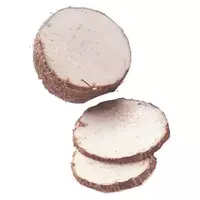Colocasia edible

Edible colocasia belongs to the genus of perennial plants of Colocasia, which are also included in the Aroid family. In nature, colocasia edible is found in the tropical climate of countries such as the Philippine Islands, Burma and New Guinea. It is worth noting that edible colocasia refers to products of plant natural origin, which for thousands of years have been used in the search for residents of the plant growing region.
Often, edible colocasia is called nothing more than taro or dashin, as well as ancient colocasia. At its core, the edible colocasia is a herbaceous perennial edible plant assigned to the genus of the same name, as well as the Aroid family. Such a type of food plant as colocasia edible is especially popular in Africa, as well as Southeast Asia.
Currently, due to the unique nutritional properties and vitamin-mineral composition, the colocasia edible plant is cultivated in the tropical regions of planet Earth. Edible taro colocasia received its second original name thanks to the inhabitants of Tahiti, where the root crop of the plant has also been used for culinary purposes for a long time. It is worth noting that an infinite number of cultivated species of a plant such as colocasia edible currently exist in the Hawaiian Islands and Tahiti.
Taro or colocasia edible is considered one of the most ancient vegetable crops that were used two thousand years ago in the cooking of ancient Indian and Egyptian civilization. The researchers were able to find a mention of colocacy edible in the records of the Roman writer and at the same time the famous polymath Pliny the Elder, who wrote a fundamental work called Natural History.
What is remarkable is that there are now fewer places on planet Earth. Where would wild species of taro plant occur. Mostly humans cultivate edible colocasia species on an industrial scale. Such a plant as colocasia edible boasts a perfectly balanced naturally vitamin-mineral composition, which is enriched with a significant amount of vitamins of group A, B, C, E, K.
In addition, taro contains magnesium, iron, potassium, phosphorus, manganese, zinc and other compounds that are certainly useful for the human body in its chemical composition. Colocasia tubers that have previously undergone thermal culinary treatment are consumed. As a rule, tarot tubers are boiled or fried. Home baked goods are especially popular, the filling for which is crushed colocasia tubers.
In addition to taro tubers, young shoots and leaves of edible colocasia are used for food. The plant tastes and resembles fresh asparagus in its consumer qualities. Colocasia tubers are ground into flour, and the plant is also considered an indispensable component of folk medicine in Polynesia, Africa and Southeast Asia.
Colocation edible 112 kCal
Energy value of colocasia edible (Ratio of proteins, fats, carbohydrates - ju):
Proteins: 1.5 g (~ 6 kCal)
Fats: 0.2 g (~ 2 kCal)
Carbohydrates: 26.46 g (~ 106 kCal)
Energy ratio (bj | y): 5% | 2% | 95%
 Español
Español Français
Français Português
Português Русский
Русский 简体中文
简体中文 繁體中文
繁體中文 日本語
日本語 한국어
한국어 العربية
العربية Türkçe
Türkçe Қазақ
Қазақ Deutsch
Deutsch Italiano
Italiano Українська
Українська
